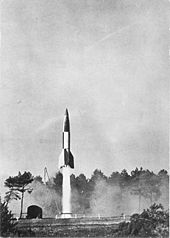- Operation Backfire (WWII)
-
Operation Backfire was a military scientific operation during and after World War II, which was performed mainly by British staff. It was part of the Allies' scramble to loot as much German technology as they could.
For this operation, four V-2 rockets were launched during October 1945 from a launch pad at 53°50′50″N 8°35′32″E / 53.84722°N 8.59222°E north-east of Arensch near Cuxhaven in Germany, in order to demonstrate the weapon to Allied personnel.
The Americans had already taken away most of the V2 rocket technology from the German underground Mittelwerk factory at the Mittelbau-Dora concentration camp near Nordhausen. Before the Soviets took control of that area, the British were given the opportunity to gather material. They were able to assemble parts sufficient to build eight V2 rockets. Some parts were still missing and there was a search throughout Germany. Some 400 railway cars and 70 Lancaster flights were used to bring the quarter-of-a-million parts and 60 specialized vehicles to Cuxhaven, the most elusive part being batteries to operate the guidance gyros. The US supplied some tail assemblies from those that they had taken. Many of the rockets and the hydrogen peroxide fuel used in the operation was provided by T-Force, a secretive British Army unit that had, in spring and summer 1945, searched for German military technology and scientists.[1]
The handling and launch procedures were unknown, so German personnel were ordered to perform these, which for the most part they did willingly[citation needed]. The launches were filmed and because the personnel wore their original uniforms and the rockets were painted in near to their original livery, this footage (often used for documentaries) has been mistaken for footage of wartime German launches.
At the site of the former launchpad there is a trough and some remnants of shelters.
During and after the launches, the British attempted to recruit German personnel, even those transferred from US custody and due to be returned, to assist with their own missile programme.
Contents
Launch details
Three rockets were launched, as follows:
Date Time Maximum height Length of flight Remarks October 2, 1945 14h41 69.4 km 249.4 km October 4, 1945 14h16 17.4 km 24 km Engine failure shortly after launch October 15, 1945 15h06 64 km 233 km Some sources indicate launch took place on October 14, 1945 October 17, 1945 80 km Final Flight See also
- Arthur Rudolph
- Cuxhaven
- Operation Paperclip
- Remnants of launchpads in Germany
- Rocket experiments in the area of Cuxhaven
According to the Report on Operation Backfire, there were three Cuxhaven launches. Backfire Rocket One was prepared for launch on 1st October but proved unwilling. Backfire Rocket Two was prepared for launch on 2nd October and was launched without difficulty. The second Cuxhaven launch took place on 4th October with our previously reluctant virgin Backfire Rocket One. A third and final rocket was launched for representatives of the press and Allies on 15th October under the name Operation Clitterhouse. (Report on Op Backfire, Vol One, Section 7, paras 100-106)
References
- ^ Longden, Sean (2009). T-Force: The race for Nazi war secrets. London: Constable. ISBN 978-1-84529-727-5
External links
- According to Renewal due for rocketservices.co.uk on 17 October 1945 there should have been a fourth launch of a V2.
- Alles ueber Modellraketenbau (German)
- V2ROCKET.COM - The A-4/V-2 Resource Site - The V-2 Rocket
- Relikte in Niedersachsen und Bremen
- Renewal due for rocketservices.co.uk
- Satellite photograph of former launch site on Google.com
Categories:- World War II guided missiles of Germany
- Non-combat military operations involving the United Kingdom
- Intelligence of World War II
- Intelligence operations
Wikimedia Foundation. 2010.

